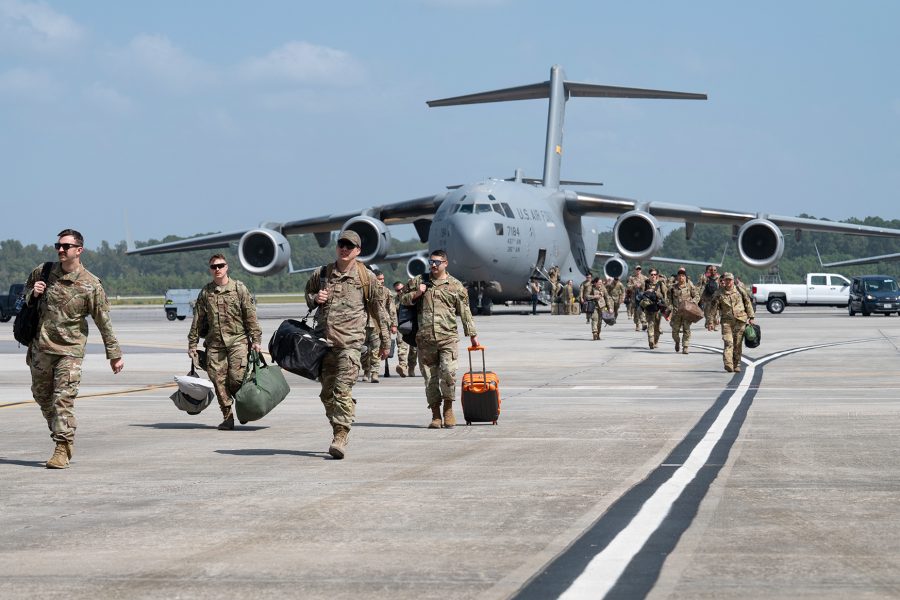The Government Accountability Office wants the Air Force to explain who will run bases when wings deploy under the service’s new force generation model along with several other unanswered questions, saying the concept is long on vision but short on details.
In a report released Nov. 26, the GAO said it recognizes USAF’s old model of “crowdsourcing” deployments to fill operational units needed to be changed. But it’s concerned that the service hasn’t yet thought through its new models, AFFORGEN and Deployable Combat Wings, and that going ahead without nailing down the specifics risks creating serious gaps and shortages.
“Continuous deployments over the past two decades have reduced the Air Force’s readiness—affecting personnel, equipment and aircraft,” the GAO wrote in the congressionally mandated audit. But the service’s answer to those issues “has challenges,” it added.
“For example, the Air Force plans to eventually deploy an entire wing from an air base rather than individuals from multiple wings and air bases. But it hasn’t assessed whether bases will have enough staff to operate when units deploy—to fill jobs like guarding entrances or providing security. Also, it hasn’t set timelines for its efforts,” the report states.
Air Force leaders have publicly acknowledged these shortcomings since starting to roll out AFFORGEN in 2022 and the Deployable Combat Wing plan was announced early in 2024. But they have also said it’s urgent to start practicing the concept without waiting for all the details to be worked out.
The GAO acknowledged the Air Force’s explanation that AFFORGEN was swiftly put into action “to prepare for potential conflict with near-peer competitors.” Service officials “recognized that an implementation plan with goals, a timeline with key milestone, and performance measures would help ensure unity of effort across the service and a shared understanding of the path forward,” the audit agency said. But it hasn’t seen those yet, it said.
In a letter to Airmen dated Oct. 22, Chief of Staff Gen. David W. Allvin said the Air Force is evolving its generation model from one that “prioritizes in-garrison efficiencies to one that prioritizes combat mission effectiveness.” Under the new system, forces will arrive in theater “pre-formed, pre-trained, and ready to fight.” As an intermediate step, six Air Task Forces have been activated and are working toward fiscal year 2026 deployments.
As for Deployable Combat Wings, Allvin said five such organizations will stand up in 2025, eight in 2026, and three in 2027. The Air Reserve Component will also start standing up DCWs in 2025, he said.
The GAO said it identified “several ongoing implementation challenge” to USAF’s plans.
The Air Force “has not completed an assessment of minimum U.S. base staffing needs,” the GAO said, and it’s unclear whether bases will have enough personnel to keep crucial functions running when the majority of their units deploy.
Also, while AFFORGEN “partially” aligns with “some selected leading reform practices,” it doesn’t align with others, the GAO said.
Those areas where USAF partially aligns with best practices in reforming its deployment model include:
- establishing goals and outcomes
- involving employees and key stakeholders
- addressing longstanding management concerns
- leadership attention and focus
- employee engagement
- strategic workforce planning.
But the service did not align with the best practices of “using data and evidence” to back up its plans, nor in “managing and monitoring” progress. The GAO said the Air Force did not fully align with any best practices for a major reorganization.
“While the Air Force has released visionary statements, it has not set goals to track implementation progress,” the agency said.
The GAO made four recommendations about the Air Force’s new deployment model:
- The Secretary of the Air Force should ensure that Headquarters Air Force “creates a plan that establishes timeframes for the [Unit Type Consolidation] effort” before Deployable Combat Wings deploy.
- The Secretary should ensure that HAF complete “a service-wide assessment of … base minimum staffing needs as it prepares to create in-garrison wings.” This plan should be coordinated with major commands and installations.
- The HAF should also “assess potential gaps and risks associated with reduced in-garrison support for base related missions,” also in coordination with MAJCOMs and installations.
- HAF should issue an AFFORGEN implementation plan “that includes leading reform practices, such as outcome-oriented goals, a timeline with key milestones, and performance measures.”
The GAO said it would report to Congress when the Air Force takes action to address the recommendations.
